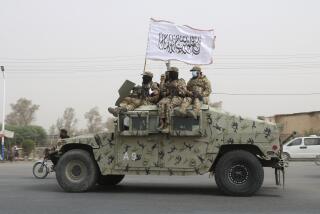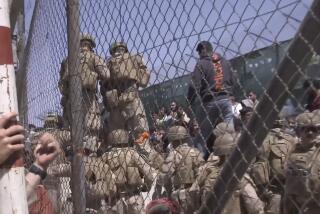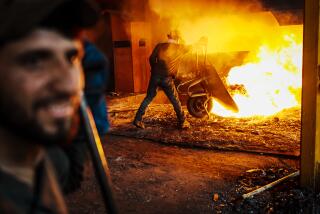Afghanistan âinsiderâ attacks pose threat to Westâs exit strategy
KABUL, Afghanistan â Theyâve been cut down while working out in makeshift gyms, as they bedded down for the night in remote combat outposts, after shrugging off heavy packs and sweat-soaked body armor when they returned from patrol.
At the height of this dusty summer, American troops are dying at unprecedented rates at the hands of their Afghan allies. And both sides are struggling to explain why, even as they search for ways to stem what are known in military parlance as âinsiderâ attacks.
This month, at least 10 U.S. troops â including a U.S. service member shot Sunday and five members of Americaâs elite special-operations forces slain earlier â have been killed by Afghan police, soldiers or civilian workers at military installations. As of Sunday, that accounted for a stunning 32% of the 31 American military fatalities in Afghanistan reported thus far in August by the monitoring website icasualties.org.
Aside from the devastating emotional blow dealt to families of the slain service members and the effect on morale in field units, insider shootings have wider-ranging repercussions. They have provided a propaganda bonanza to the Taliban, and could threaten a linchpin of the Western exit strategy: training Afghan security forces in preparation for handing over most fighting duties to them by 2014.
The military says only a very small share of insider attacks is carried out by Taliban âsleepersâ in the police or army. But that opens the way to perhaps an even more alarming conclusion: that the majority of the assailants are undertaking what are in effect spontaneous, self-assigned suicide missions, because many insider shooters are killed on the spot in return fire.
The military says it is working to address the threat. Changes in recent months have included the posting of armed Western troops â so-called guardian angels â to watch over others in mess halls, sleeping tents and gyms. Last week, the American commander of the NATO force, Gen. John Allen, ordered that NATO troops across Afghanistan keep a loaded magazine in their weapons, even when on base.
This year, an Army captain described an informal buddy system at his base of troops signaling each other to keep a close watch on armed Afghans nearby, especially if one of their comrades was diverted by some task.
ââShona-ba-shona,â OK,â the captain said, invoking the âshoulder-to-shoulderâ slogan of the NATO force and its Afghan partners. âBut also: âEyes on, all times.ââ
In public, Western military officials in Afghanistan have consistently sought to play down the overarching significance of such attacks, describing them as an occasional violent anomaly in an otherwise effective and mutually respectful working relationship between Afghan security forces and the NATO troops training them.
âEvery day, you have 500,000 soldiers and police working and fighting side by side â you talk to these guys, and they tell you they are building trust and friendship,â said Brig. Gen. Gunter Katz, a spokesman for NATOâs International Security Assistance Force, referring to the approximate combined numbers of Afghan and Western forces.
But disquiet is being expressed in high echelons. Defense Secretary Leon E. Panettatold reporters in Washington last week that he was âvery concernedâ about the recent spate of insider attacks, and he called President Hamid Karzai over the weekend to talk about the need for tougher selection standards for the Afghan armed forces. How to guard against such attacks is the subject of considerable debate in military leadership circles, because overtly heavy-handed measures can send a signal to the Afghans that they are not trusted, which can be taken as an insult. And in traditional Afghan culture, perceived insult can swiftly lead to exactly the sort of violence the attacks represent.
Efforts on the Afghan side include assigning undercover intelligence officers to some battalions, and stricter scrutiny of recruits, including the collection of biometric data to compare against a database of known insurgents. Some observers, though, believe the safeguards built into the recruitment process, including the requirement that village elders vouch for those who want to join the army, are routinely bypassed in many provinces.
âIt all goes to the vetting process, to the hurry the international community is in to produce soldiers,â said Daoud Sultanzoy, a former member of parliament and broadcaster.
Many explanations have been floated for Afghans turning their guns on members of the U.S.-led North Atlantic Treaty Organization force: stress, battle fatigue, personal antagonism, cultural misunderstandings, copycat psychology, heat-of-the moment disputes in a society where arguments are often settled with a Kalashnikov.
The phenomenon is so pervasive that the killings have their own evolving nomenclature. Previously, the military called them green-on-blue attacks, a color-coded reference to Afghan and Western forces. Now the preferred, more encompassing term is âinsider threat,â stemming from the fact that assailants have included not only uniformed police and soldiers, but also civilian members of the Afghan security apparatus, or simply someone with access to a coalition base, even in a low-level capacity.
The Taliban movement has noted the rising number of insider shootings with ill-concealed delight, boasting of having infiltrated all branches of the Afghan security forces. In the past, the Taliban leadership claimed responsibility for virtually every such attack, but lately the groupâs publicity machine often cites individual initiative by those without links to the insurgency.
âOur fighters are in the ranks of the police, army and intelligence service, but there are also some who carry out attacks on foreign troops only because they are Afghans and Muslims and act on their religious obligation to protect their country from invading forces,â said Zabiullah Mujahid, a spokesman for the group. âIt is an indication of utter hatred against the foreigners.â
Motivation for the attacks remains opaque in many instances, either because the shooter is killed or manages to escape, in some cases with the suspected collusion of local authorities. Family members generally shed little light on what might have caused a relative to turn his gun on Western mentors.
âHe had very good relations with the foreigners, and he was trusted and liked by them,â said Shamsullah Sahrahi, a tribal elder whose policeman son, Assadullah, stands accused in an insider attack this month in Helmand province. Local officials said Assadullah had invited a group of U.S. Marines to one of the nighttime meals that observant Muslims eat during the dawn-to-dusk fasting month of Ramadan, where three were shot dead and a fourth wounded.
Among Afghans, particularly those serving in the security forces, the reaction to news of yet another insider attack can vary. Some express genuine-seeming shock and sadness; others voice fears that the assaults will accelerate the Western pullout and leave them unprepared to take on the Taliban alone; others suggest that foreign troops bring it on themselves.
âItâs not good when these things happen,â said a 21-year-old Afghan army recruit waiting in line at a Kabul military induction center. âBut well, maybe itâs because of the Koran-burning,â a reference to the accidental incineration of Muslim holy books by U.S. troops in February, which set off days of deadly rioting.
Higher-ranking Afghan officials are much more likely to offer an unequivocal condemnation of the attacks, sometimes in florid terms. âI wish I could open up my chest and show the pain I feel in my heart,â Col. Mohammad Akbar Stanikzai, an intelligence officer at the Afghan armyâs recruitment headquarters in Kabul, said when asked about the phenomenon.
Some analysts believe part of the problem is the sheer longevity of the war, now in its 11th year. In the conflictâs early stages, such attacks were an extreme rarity.
âI wouldnât say itâs normal, but I think itâs understandable in a war situation which is lasting for more than a decade,â said Fabrizio Foshini of the Afghan Analysts Network. âThe conflict has been becoming worse, nastier â and the presence of foreign troops doesnât seem in the eyes of many Afghans to have brought positive changes.â
Special correspondents Hashmat Baktash and Aimal Yaqubi contributed to this report.
More to Read
Sign up for Essential California
The most important California stories and recommendations in your inbox every morning.
You may occasionally receive promotional content from the Los Angeles Times.










